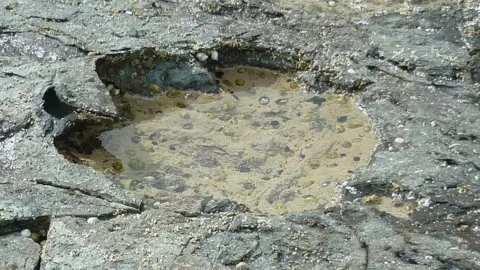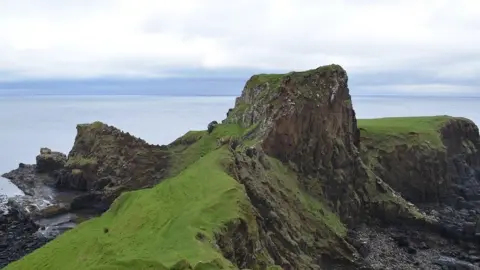Dinosaur tracks on Skye 'globally important'
New light has been shed on a little understood period of dinosaur evolution after giant prehistoric footprints were discovered on the Isle of Skye.
Researchers, including some from Edinburgh University, have been analysing dozens of the footprints, left about 170 million years ago.
They found that the tracks belonged to sauropods and therapods from the Middle Jurassic period.
The discovery has been described as being "globally important".
Few fossil sites have been found around the world from the Middle Jurassic period.
The footprints, left in a muddy, shallow lagoon, are helping the researchers build a more accurate picture of an important period in dinosaur evolution.
 Jon Hoad
Jon HoadMost of the prints were made by long-necked sauropods - which stood up to 2m (6.5ft) tall - and by theropods, which were the older cousins of Tyrannosaurus Rex.
Researchers measured, photographed and analysed about 50 footprints in a tidal area at Brothers' Point - Rubha nam Brathairean - a headland on Skye's Trotternish peninsula.
The footprints were difficult to study owing to tidal conditions, the impact of weathering and changes to the landscape but the scientists identified two trackways in addition to many isolated footprints.
Analysis of the clearest prints enabled scientists to ascribe them to sauropods and theropods.
 Streve Brusatte
Streve BrusatteThe study, carried out by the University of Edinburgh, Staffin Museum, and the Chinese Academy of Sciences, was published in the Scottish Journal of Geology.
Paige dePolo, who led the study said: "This tracksite is the second discovery of sauropod footprints on Skye. It was found in rocks that were slightly older than those previously found at Duntulm on the island and demonstrates the presence of sauropods in this part of the world through a longer timescale than previously known.
"This site is a useful building block for us to continue fleshing out a picture of what dinosaurs were like on Skye in the Middle Jurassic."
Dr Steve Brusatte, of the University of Edinburgh's School of GeoSciences, who led the field team, said: "The more we look on the Isle of Skye, the more dinosaur footprints we find.
"This new site records two different types of dinosaurs-long-necked cousins of Brontosaurus and sharp-toothed cousins of T-Rex-hanging around a shallow lagoon, back when Scotland was much warmer and dinosaurs were beginning their march to global dominance."
